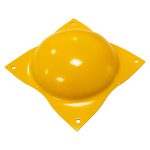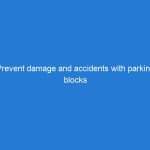Introduction
Road safety is a matter of paramount importance that tends to be overlooked until tragedy strikes. Every year, road accidents account for a significant number of fatalities and serious injuries worldwide. The safety of road users, from pedestrians to cyclists and motorists, is a serious concern that calls for a comprehensive approach. Among the myriad of measures that have been devised to curb the menace of road accidents, one particular solution that stands out for its simplicity and effectiveness is the use of light reflective speed bumps.
The use of light reflective speed bumps is a strategic approach to promoting road safety. Speed bumps are essentially elevated sections of a road that are designed to slow down or deter speeding. They play a critical role in controlling the speed of vehicles, especially in areas with a high pedestrian presence or where there are safety concerns such as school zones, residential areas, and hospitals. The introduction of light reflective features to these speed bumps enhances their visibility, making them even more effective in promoting road safety.
The light reflective speed bumps are a modern take on the traditional speed bumps. They are made from high-density recycled rubber and painted in distinct yellow and black colors. The addition of a light reflective chevron on each middle section presents a sophisticated design that effectively shows the direction flow for approaching traffic. This prominent feature is what sets them apart from the traditional speed bumps and bolsters their functionality significantly.
With the light reflective chevrons, these speed bumps are highly visible at all times of the day. Whether under the bright midday sun or in the pitch darkness of the night, they remain conspicuous, guiding motorists and reducing the risk of accidents. Road safety is a 24/7 concern, and these markings ensure that the speed bumps for driveway maintain their role of keeping roads and lanes safe round the clock.
A striking feature of these light reflective speed bumps is the use of recycled rubber in their construction. In an age where environmental conservation is a pressing issue, the use of recycled materials in road safety solutions is indeed a step in the right direction. It not only makes these speed bumps durable and resistant to wear and tear but also contributes to the reduction of environmental pollution.
In this article, we delve deeper into the concept of light reflective speed bumps, their benefits, potential drawbacks, and additional safety measures that can be incorporated to enhance road safety. We also discuss the importance of road safety and ways to ensure safety on roads. As we navigate through these points, the emphasis is on the critical role that these simple yet efficient devices play in our day-to-day life.
What Are Light Reflective Speed Bumps?
Light reflective speed bumps are a ground-breaking innovation in the domain of traffic control and road safety. While many of us are familiar with the concept of speed bumps, light reflective speed bumps take the idea a step further, adding a layer of visibility that ensures they perform their function day and night.
To begin with, let’s understand what speed bumps are. They are essentially traffic calming devices that use vertical deflection to slow down motor-vehicle traffic in order to improve safety conditions. Speed bumps are typically placed in areas where there is a high pedestrian presence, such as schools and hospitals, or in residential neighborhoods where fast-moving traffic is detrimental to the community’s safety.
Delving deeper into our topic at hand, light reflective speed bumps are not very different from traditional speed bumps in their primary function – slowing down traffic. Where they differ, however, lies in their visibility. These speed bumps are crafted from high-density recycled rubber that is painted in a combination of yellow and black. These colors are not chosen haphazardly. The yellow and black pattern is a universally recognized symbol for caution, thus making these speed bumps noticeable during the day.
The unique factor in these speed bumps is the light reflective chevron painted on each middle section. This chevron serves to direct the flow of traffic, ensuring drivers are aware of which side to pass the bump from. These markings play a pivotal role in increasing visibility during low light conditions, such as at night or during bad weather. The reflective chevrons light up when headlights shine on them, making the bumps stand out and alerting drivers well in advance.
The materials used in the construction of these speed bumps contribute significantly to their durability and effectiveness. High-density recycled rubber is robust and resistant to various weather conditions. This means that these speed bumps can withstand heavy traffic and harsh weather, without losing their functionality or visibility. Furthermore, by using recycled rubber, manufacturers are also contributing to environmental sustainability.
In conclusion, light reflective speed bumps are an ingenious blend of simple technology and effective design aimed at ensuring road safety. Their high visibility, both during the day and at night, coupled with the resilience of the materials used in their construction, make them a reliable tool in managing traffic speed and preventing accidents.
Advantages of Light Reflective Speed Bumps
One of the most significant advantages of light reflective speed bumps is their ability to reduce traffic speed effectively. Speed bumps are known for their effectiveness in slowing down vehicles, but the light reflective variety adds an additional layer of safety. As vehicles approach these speed bumps, the reflective chevrons on each middle section guide the driver’s attention to the bump ahead, alerting them to prepare to slow down. This is particularly beneficial in residential areas and school zones where high speeds can lead to serious accidents.
The impact of slowing traffic to a maximum speed of 10 mph cannot be underestimated. At this speed, vehicles have much more time to react to unexpected situations such as a child chasing a ball into the street, a dog running loose or a pedestrian crossing the road. This reduction in speed dramatically reduces the risk of accidents, resulting in safer neighborhoods and peace of mind for residents.
Light reflective speed bumps not only protect pedestrians but also property. In parking lots, for example, these bumps ensure that drivers maintain a safe speed, reducing the likelihood of collisions with parked cars, shopping carts, or other obstacles. They also prevent reckless drivers from using these areas as shortcuts or race tracks, ensuring public safety and property protection.
Another significant advantage of these speed bumps is their high visibility, particularly at night. Made from high-density recycled rubber and painted in yellow and black, these bumps are designed to be highly visible even during the night. The reflective chevrons on the middle section of the bump provide clear direction flow for approaching traffic. This feature ensures that drivers are aware of the bump long before they reach it, allowing them to reduce their speed in a controlled manner, thereby preventing damaging impacts.
Despite the clear benefits of these speed bumps, it’s worth noting that they are not a standalone solution. They form part of a broader system of road safety measures which may include warning signs, lane dividers, and speed cameras. Yet, factor in their cost-effectiveness as they are made from recycled materials, and their resilience, needing little to no maintenance, and it’s easy to see why light reflective speed bumps are an increasingly popular choice for traffic calming.
In conclusion, the advantages of light reflective speed bumps extend beyond the immediate impact of reducing speed. They increase road safety through their heightened visibility, especially at night, protect both pedestrians and property, and contribute to a broader system of traffic calming measures. As we continue to strive for safer roads, the role of light reflective speed bumps is pivotal, and their adoption should be seen as a significant step towards this goal.
Conclusion
In wrapping up this detailed exploration of light reflective speed bumps and their contribution to road safety, it’s evident that these simple yet effective traffic calming devices carry significant advantages. As noted, they are designed to show a concrete commitment to preserving human life and properties by enforcing a maximum speed of 10 mph. This speed restriction ensures that drivers have enough reaction time to avoid accidents, thereby protecting pedestrians and properties located near the road.
Light reflective speed bumps, as the name suggests, are easily visible at night. The high-density recycled rubber used in their construction is painted in bold yellow and black colors, and a light reflective chevron is marked on each middle section. This feature ensures that approaching traffic can adequately see them, irrespective of the time of day. The ceaseless vigilance that these speed bumps provide makes them an indispensable part of road safety strategies.
Moreover, it’s worth stressing the environmental benefits of light reflective speed bumps. Made from high-density recycled rubber, they present an excellent example of how we can leverage waste materials for a considerably beneficial cause. This attribute not only gives them a robust and durable structure but also contributes to the sustainable management of resources.





